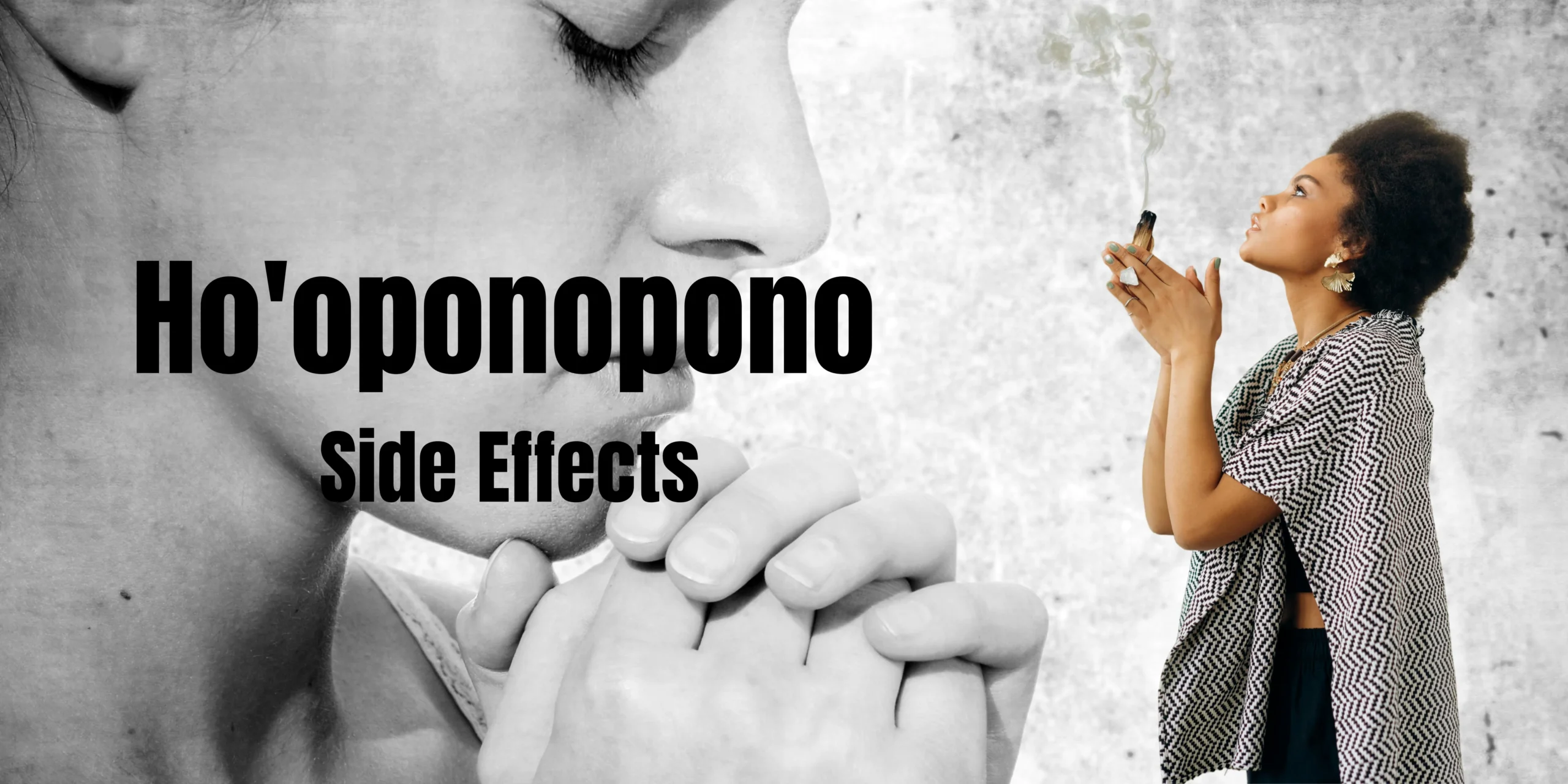Hey, are eager to know about Ho’oponopono Side Effects, then must go through this article, this is absolutely for you.
What is Ho’oponopono?
Healing and remorse are at the core of the ancient Hawaiian healing method known as ho’oponopono. The term itself means “to make right” or “to rectify an error.” This ancient practice emphasizes accepting responsibility for one’s own reality and recognizing the interdependence of mind, body, and spirit.
How does Ho’oponopono work?

Ho’oponopono is based on the core concept that our outer reality represents our inner state. Four crucial phrases are used throughout the process: “I’m sorry, please forgive me, thank you, and I love you.” Practitioners think that repeating these lines starts a transforming inner dialogue.
Acceptance of Personal accountability:
The practice begins with accepting personal accountability for the difficulties or negativity encountered.
Forgiveness:
Forgiveness is the core theme of Ho’oponopono. Individuals express remorse and seek forgiveness to remove bad emotions and energy related with past events or relationships.
Gratitude:
The expression of gratitude that follows expresses thankfulness for the opportunity to heal and transform. Gratitude is seen as a potent force that aids in the whole cleansing process.
Love:
The final step is to acknowledge your love. Individuals who cultivate a sense of love and compassion try to replace negativity with positive energy, building a harmonious internal and external environment.
How to do Ho’oponopono?

“I’m sorry, please forgive me, thank you, I love you.” These are the key phases of Ho’ponopono:
- Find a Quiet Space:
- Begin by finding a quiet and comfortable space where you can be alone with your thoughts. This can be a corner in your home, a serene outdoor spot, or any place where you feel at ease.
- Center Yourself:
- Take a few moments to center yourself. Close your eyes, take a few deep breaths, and let go of any tension or stress. Create a mental space for self-reflection.
- Repeat the Four Phrases:
- Start repeating the four Ho’oponopono phrases: “I’m sorry, please forgive me, thank you, I love you.” You can say them out loud or in your mind. The order can vary based on what feels right for you.
- Focus on Intention:
- As you repeat the phrases, focus on the intention behind each one. Feel genuine remorse for any negative experiences, seek forgiveness, express gratitude, and cultivate a sense of love and compassion.
- Direct the Practice Inward:
- Ho’oponopono is a personal practice, so direct it inward. Instead of addressing specific individuals, consider it a conversation with your higher self, the universe, or whatever resonates with your beliefs.
- Embrace Forgiveness:
- Allow yourself to embrace forgiveness both for your own actions and for external circumstances. Recognize that forgiveness is a powerful tool for releasing negative energy and promoting healing.
- Repeat Regularly:
- Make Ho’oponopono a regular part of your routine. You can practice it daily, perhaps in the morning or before bedtime, or use it whenever you encounter challenges or negative emotions throughout the day.
- Integrate into Challenging Situations:
- When faced with challenging situations or conflicts, silently repeat the phrases to yourself. This can help diffuse tension, shift your perspective, and contribute to a more positive outcome.
- Combine with Meditation or Mindfulness:
- Consider combining Ho’oponopono with meditation or mindfulness practices.
- Be Patient and Consistent:
- Healing is a process, and Ho’oponopono is no different. Be patient with yourself and consistent in your practice.
Best Time for Ho’oponopono

There’s no strict rule on when to practice Ho’oponopono, here are some suggestions that you can consider:
- Morning Ritual:
- Many people find that practicing Ho’oponopono in the morning sets a positive tone for the day. It can be integrated into your morning ritual, perhaps right after waking up or during your meditation routine.
- Before Bedtime:
- Evening is another opportune time for Ho’oponopono. Reflecting on the events of the day and clearing your mind before bedtime can contribute to a restful night’s sleep.
- During Stressful Moments:
- Whenever you encounter stressful or challenging situations, consider practicing Ho’oponopono in the moment.
- Midday Break:
- Taking a break in the middle of the day to practice Ho’oponopono can offer a moment of reflection and rejuvenation.
- Integration with Meditation:
- If you already have a meditation practice, consider integrating Ho’oponopono into your meditation sessions.
- In Nature:
- Some individuals prefer to practice Ho’oponopono in natural settings. Whether it’s a park, garden, or beach, being in nature can amplify the healing effects of the practice.
- During Exercise:
- If you have a regular exercise routine, such as walking, jogging, or yoga, you can incorporate Ho’oponopono during these activities.
- Adapting to Your Schedule:
- Ultimately, the best time for Ho’oponopono is the time that fits seamlessly into your schedule. Choose a time that feels natural for you and allows you to be fully present in the practice.
Remember, the effectiveness of Ho’oponopono lies in the consistency of your practice rather than the specific time of day.
Ho’oponopono Benefits

Reducing Stress:
Ho’oponopono is well known for its capacity to resolve and release unpleasant emotions, thereby reducing stress. By fostering an attitude of forgiveness, the practice helps people feel less mentally burdened.
Reducing Depression and Anxiety:
Professionals frequently report a decrease in anxiety and depressive symptoms. The emphasis on self-examination and forgiveness leads to a more optimistic and well-rounded mental perspective.
Enhanced Mental Well-Being:
Through the provision of a framework for self-discovery and emotional healing, the practice enhances general mental health.
Diseases Connected to Stress:
Ho’oponopono indirectly treats conditions that are brought on by or made worse by stress. Through the facilitation of stress reduction, the practice enhances general physical wellness.
Enhanced Immune Response:
It is thought that Ho’oponopono, which promotes mental and emotional equilibrium, has a beneficial effect on the immune system and may strengthen the body’s defenses against disease.
Release of Emotions:
Pent-up emotions may be initially released as a result of the practice. Even though it can be quite intense, this is thought to be a normal and essential step in the healing process.
Transient Uncomfort:
When people face buried feelings and experiences, they could feel uncomfortable for a while. This is a temporary soreness that is part of the cleansing process.
Mind and Soul Detoxification:
Ho’oponopono is frequently compared to a cleansing of the mind and soul.
Application Flexibility:
Ho’oponopono is not limited to any one aspect of existence.
Positive Relationship Impact:
Ho’oponopono can have a positive impact on relationships by encouraging forgiveness and personal responsibility, resulting in enhanced communication and a deeper knowledge of oneself and others.
Increased Happiness:
Many practitioners provide moving testimonies about how Ho’oponopono has improved their general well-being, leading to a more satisfying and meaningful life.
Practical Implementation Advice:
The practice provides practical implementation advice, such as incorporating it into regular routines and applying it during difficult times, to increase its usefulness in real-life settings.
Other Practises Complementary:
Ho’oponopono can be coupled with other practices such as meditation, mindfulness, affirmations, and visualization to maximize the advantages of these combined approaches.
Recognition in Contemporary Psychology:
Modern psychology recognizes overlapping concepts between Ho’oponopono principles and therapeutic approaches, demonstrating its significance in contemporary mental health thinking.
Continuous Learning and Development:
Ho’oponopono is more than a set of procedures; it is a lifelong journey of self-discovery and progress. Practitioners have a changing understanding of themselves, which promotes constant learning.
Ho’oponopono Side Effects

Although Ho’oponopono is the simpliest way to heal the inner self, it is important to know Ho’oponopono Side Effects before the implication
- Initial Emotional Release: (Ho’oponopono Side Effects)
- Some practitioners may experience an initial release of pent-up emotions. This emotional catharsis is a natural part of the healing process as individuals confront and let go of buried emotions.
- Temporary Discomfort: (Ho’oponopono Side Effects)
- During the early stages of Ho’oponopono, individuals might encounter temporary discomfort. This discomfort arises as they confront and address deep-seated emotions and memories. It is a transient phase on the path to healing.
- Detoxification Process: (Ho’oponopono Side Effects)
- Ho’oponopono is often compared to a detox for the mind and soul. The side effects, such as emotional releases and discomfort, are indicative of the cleansing process as individuals release negativity and make space for healing.
- Intensification of Existing Issues: (Ho’oponopono Side Effects)
- In some cases, the practice may initially intensify existing emotional issues. This is a natural part of the healing journey as individuals bring buried emotions to the surface for acknowledgment and release.
- Increased Awareness: (Ho’oponopono Side Effects)
- Practicing Ho’oponopono may lead to increased awareness of one’s thoughts and emotions. This heightened awareness can, at times, feel overwhelming as individuals become more attuned to their internal processes.
- Shift in Perspective: (Ho’oponopono Side Effects)
- The practice often brings about a shift in perspective, challenging existing belief systems. This shift can create temporary discomfort as individuals navigate through changes in their understanding of themselves and their reality.
- Resistance and Skepticism: (Ho’oponopono Side Effects)
- Some individuals may initially resist the practice or approach it with skepticism. Resistance is a common side effect, especially when the process challenges deeply ingrained thought patterns and beliefs.
- Emotional Vulnerability: (Ho’oponopono Side Effects)
- Engaging in Ho’oponopono may lead to a sense of emotional vulnerability. As individuals open themselves to forgiveness and self-reflection, they may experience a period of emotional sensitivity.
- Impact on Relationships: (Ho’oponopono Side Effects)
- The practice’s emphasis on forgiveness may impact relationships, especially if it involves addressing past grievances. While the ultimate goal is healing, the process can be challenging as individuals navigate changes in dynamics.
- Integration Challenges: (Ho’oponopono Side Effects)
- Integrating Ho’oponopono into daily life may pose challenges. Finding the balance between regular practice and other commitments can be a side effect for individuals adjusting to the demands of the healing journey.
- Unpredictable Emotional Responses: (Ho’oponopono Side Effects)
- Emotional responses during Ho’oponopono can be unpredictable. Individuals may experience a range of emotions, from joy and relief to temporary sadness or frustration, as they navigate the complexities of their inner world.
- Impact on Routine: (Ho’oponopono Side Effects)
- The practice may disrupt established routines as individuals make time for self-reflection and forgiveness. Adjusting to this change can be a side effect, requiring a period of adaptation.
- Release of Subconscious Patterns: (Ho’oponopono Side Effects)
- Ho’oponopono aims to address deep-seated subconscious patterns. The release of these patterns may lead to temporary emotional and mental upheaval as individuals confront and transform ingrained beliefs.
- Personal Accountability Challenges: (Ho’oponopono Side Effects)
- Embracing personal accountability, a core aspect of Ho’oponopono, can be challenging. Accepting responsibility for one’s reality may trigger resistance or discomfort as individuals confront their role in past experiences.
- Integration with Daily Activities: (Ho’oponopono Side Effects)
- Integrating the practice seamlessly into daily activities may take time. Individuals may initially find it challenging to apply Ho’oponopono principles in various life situations, resulting in a learning curve.
Note: These side effects is essential for individuals embarking on the Ho’oponopono journey. While the process may bring about temporary challenges, the ultimate aim is holistic healing and a profound transformation of the self.
Referrance: MarbelKatz, deephoponopono
To Know more about side effects CLICK HERE
Conclusion
In conclusion, we can say that It’s totally clear from what we have learned in every aspect of this traditional Hawaiian healing technique that the advantages greatly exceed the drawbacks. Although there may be initial difficulties on the path of self-discovery, forgiveness, and healing, these are necessary for the significant transformations that Ho’oponopono can effect.
